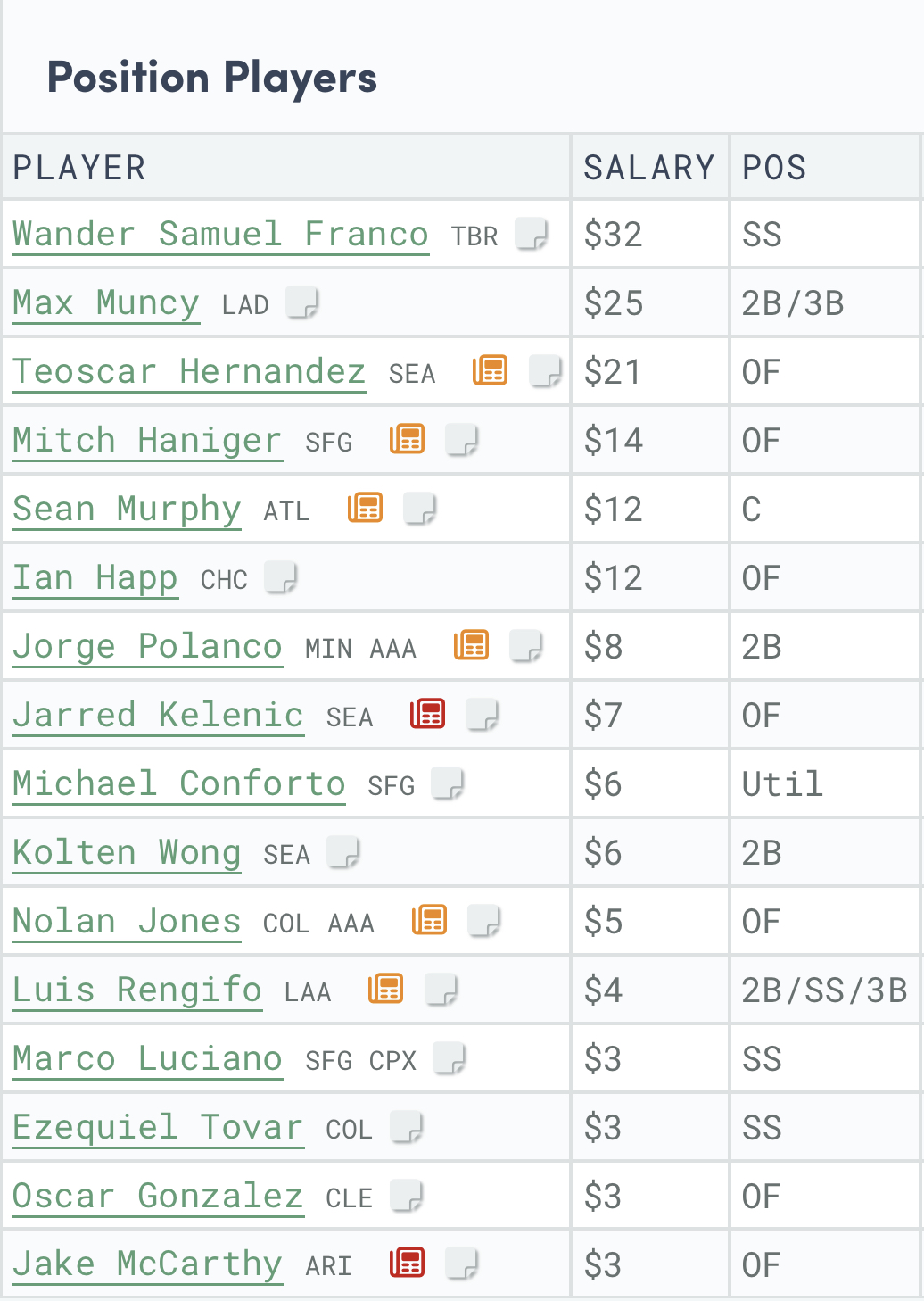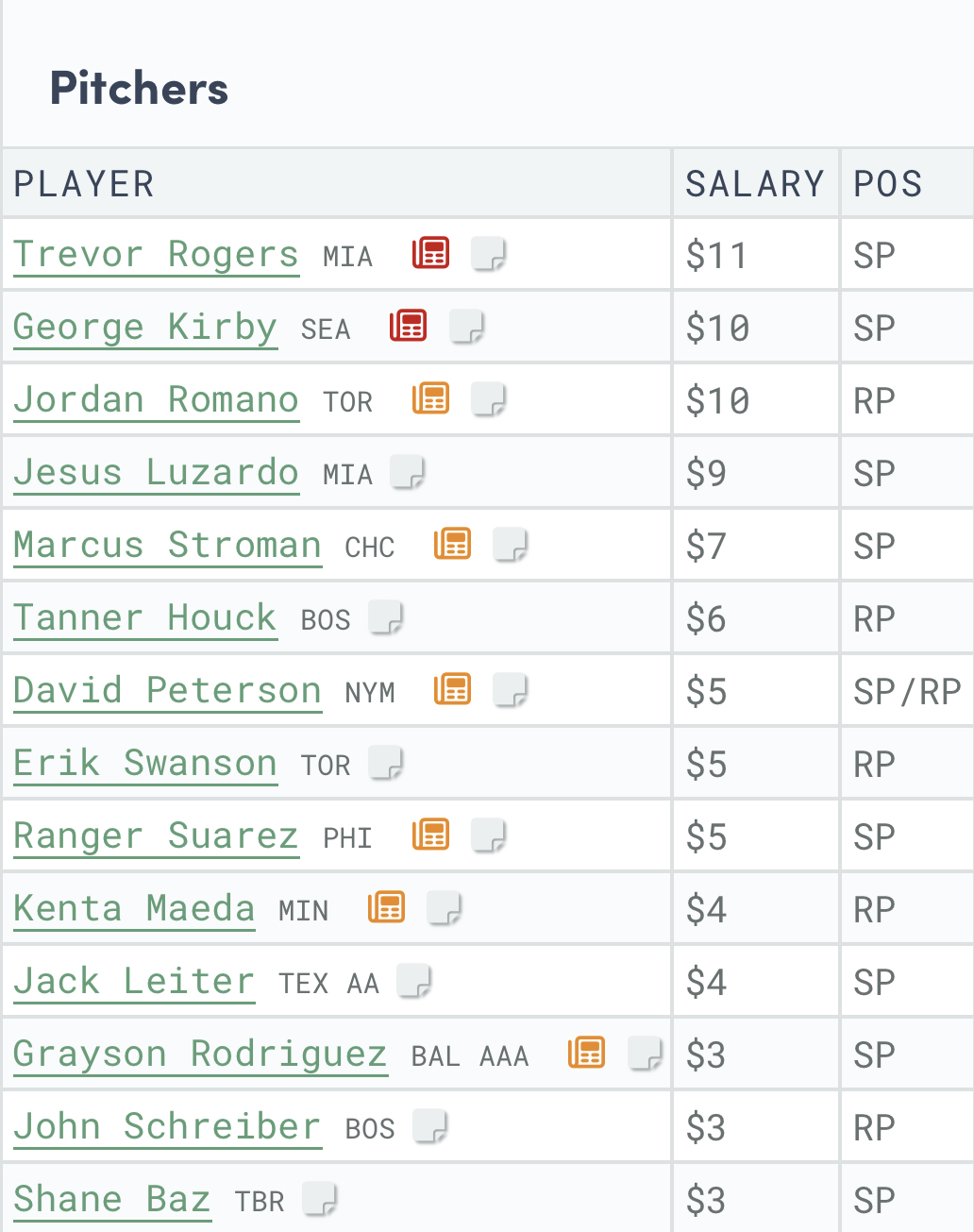The Anatomy of a Ottoneu Dynasty Rebuild: Part 4, Ahead of Schedule
We’re about a month into the season now which means you’re probably getting a good feel for the direction your fantasy teams are headed this year. Maybe your roster has been wracked with injuries or you’ve hit the jackpot on the sleepers you picked up this offseason. This year, I’ve been writing up my experience of rebuilding my Ottoneu team in League 32 – Fantasy Field of Dreams; I’ve covered making the initial decision to rebuild, some general draft strategy for rebuilding clubs, and the dilemma I faced with the draft this year. Now is a pretty good time to check in on how things are progressing for The Wanderers.
The Draft
Before we dive in on what’s going on with the team now that the regular season is underway, I want to take a quick moment to recap what happened in the draft. If you remember, I had a significant amount of cash to spend on relatively few roster spots. I was targeting a starting second baseman and a high-end outfielder while spreading the rest of my cap space out between some depth options.
Folks, let me tell you, I seriously underestimated the amount of inflation present in the league. My top target, Mookie Betts, went for $70 and I drove the price up that high in a bidding war with the eventual winner. I just couldn’t bring myself to bid that one extra dollar after he hit that $70 threshold. There were a number of points in the draft where I had to bow out of the bidding on a target because the eventual price was just getting too high. I felt some particular pressure trying to find an outfielder; I had shifted my eyes towards some of the mid-tier options after some salary cap opened up by missing out on Betts. I let Masataka Yoshida ($35), Christian Yelich ($27), Jesse Winker ($28), Nick Castellanos ($26), and Cedric Mullins ($22) all go to other players after their salaries got too high and eventually settled for Lourdes Gurriel Jr. at $16. I did end up getting a couple of my high priority targets — Bryce Harper ($43), Spencer Steer ($8), Spencer Torkelson ($9), and Reid Detmers ($11) — but I felt like I was on the back foot during the entire draft, continually making contingency plans as players came off the board with values way over what I was comfortable with.
Here are the 10 players I had selected by the end of the draft:
| Player | Salary | Pts/G/IP |
|---|---|---|
| Bryce Harper | $43 | N/A |
| Brandon Lowe | $27 | 5.79 |
| Spencer Steer | $8 | 5.24 |
| Clarke Schmidt | $11 | 1.81 |
| Spencer Torkelson | $9 | 3.21 |
| Reid Detmers | $11 | 3.41 |
| Lourdes Gurriel Jr. | $16 | 4.05 |
| Hayden Wesneski | $6 | 1.43 |
| Kyle Manzardo | $3 | N/A |
| Eric Haase | $1 | 2.54 |
Brandon Lowe turned out to be a pretty good backup pick after missing out on Betts, though most of the other available second basemen in the draft have performed rather well to start this season too. Steer has looked great and Gurriel has been okay. The pitching depth I picked up hasn’t been all that impressive, but all three of them are young and still have the potential to breakout that made them such enticing options. It wasn’t the most successful draft I’ve ever had, but it wasn’t terrible, particularly considering how wayward my plans went.
Breakouts!
On April 26, my team is currently sitting in sixth place, less than 500 points behind first place and right in the middle of a group of seven teams separated by less than 100 points.
| Team | Points | P/G | P/IP |
|---|---|---|---|
| Spuds and Zucchini 🥔 | 3098.7 | 5.50 | 5.69 |
| Down by the Schoolyard | 2966.9 | 5.18 | 6.18 |
| Beck Panthers | 2960.1 | 5.18 | 5.39 |
| Old Skool Ballers | 2686.7 | 5.18 | 4.77 |
| Ignacio Beardfacio | 2672.9 | 5.06 | 5.22 |
| The Wanderers 🚶♂️ | 2631.7 | 5.31 | 4.91 |
| Gausman Turner Overdrive 🎸 | 2629.5 | 4.67 | 5.97 |
| Sharky’s Goonies ☠️ | 2617.1 | 4.93 | 5.00 |
| Sunflower Seed Finger ☝️ | 2613.7 | 5.51 | 4.28 |
| No Vacancy | 2599.3 | 4.64 | 5.43 |
| Everyone On The Right Base | 2507.2 | 4.94 | 4.69 |
| StringerBias™️ | 2114.8 | 4.52 | 3.29 |
I have the third best offense in the league thanks to breakouts from Wander Franco (7.56 Pts/G), Jarred Kelenic (8.56), and Steer (5.24) and solid bounce back seasons from Max Muncy (8.73) and Lowe (5.79). My pitching hasn’t been as great, sitting eighth in the league by points per inning pitched. I’m not as worried about that, but it’s probably the area of the team that could use the most help at this point. All things considered, I’m extremely happy with where my team sits in the standings. Thanks to those handful of breakouts, it’s going a lot better than expected.
The big thing that could potentially have a huge impact on the direction of my team is Bryce Harper’s impending return. The latest reports have him possibly being activated as soon as early May. That might be optimistic, but he’s clearly ahead of schedule and should be contributing much earlier in the season than expected. Getting four months of production from him this year instead of the expected one or two means my team has a significant source of points that will be added to the roster — something very few other teams can claim. There’s no guarantee that he’ll produce up to his usual superstar standards, but if he does, my already great offense will only get better.
Churn Baby, Churn
One of the most important early season tasks for a rebuilding team is to churn through the waiver wire searching for potential undrafted breakouts. Every team does this as they deal with injuries and underperformance, but it’s particularly important for a team like mine since I need to infuse my roster with talent however I can. I’ve added ten players off the waiver wire, kept seven of them and have already completed an early season trade.
| Player | Transaction Type | Date | Salary |
|---|---|---|---|
| Brock Burke | add | 3/28/2023 | $3 |
| Jonathan Hernández | add | 3/28/2023 | $1 |
| Nolan Jones | cut | 3/28/2023 | $5 |
| Jack Leiter | cut | 3/28/2023 | $4 |
| Dylan Dodd | add | 4/1/2023 | $3 |
| Marco Luciano | cut | 4/1/2023 | $3 |
| Jimmy Herget | add | 4/2/2023 | $1 |
| Jimmy Herget | cut | 4/2/2023 | $1 |
| Luis García (WSN) | add | 4/9/2023 | $3 |
| Kolten Wong | cut | 4/9/2023 | $6 |
| Kris Bubic | add | 4/12/2023 | $6 |
| Oscar Gonzalez | cut | 4/12/2023 | $3 |
| Chas McCormick | add | 4/15/2023 | $3 |
| Jonah Heim | add | 4/15/2023 | $1 |
| Eric Haase | cut | 4/15/2023 | $1 |
| Tony Gonsolin | add | 4/16/2023 | $9 |
| Kris Bubic | cut | 4/16/2023 | $6 |
| Ian Hamilton | add | 4/21/2023 | $1 |
| Dylan Dodd | cut | 4/21/2023 | $3 |
| Jazz Chisholm Jr. | trade in | 4/25/2023 | $9 |
| Kyle Manzardo | trade out | 4/25/2023 | $3 |
Immediately following the draft, I started a couple of auctions for a pair of relievers I thought had some upside to chase. Brock Burke hasn’t been great (5.93 Pts/IP) but Jonathan Hernández (7.71) has been solid in high leverage work for the Rangers. Dylan Dodd looked like a promising pickup after he received an early season callup for the Braves but I ended up cutting him a few weeks later after Atlanta sent him back down to the minors. I like the improvements Luis Garíca has made to his approach at the plate and I believe in his potential to breakout this season so that was a pretty easy waiver claim after another team dropped him. I grabbed Kris Bubic after his two promising starts but his breakout was short lived after undergoing Tommy John surgery a week after adding him. Jonah Heim replaced Eric Haase as my backup catcher which has definitely worked out for the better. Tony Gonsolin was another waiver claim after another team dropped him and hopefully he can provide some upside for my pitching staff.
As for my cuts, Jack Leiter and Marco Luciano were both too expensive as prospects to keep around, especially considering the challenges they’ve faced in their development. I might regret cutting Nolan Jones if the Rockies ever give him a chance to play in the majors since he’s absolutely destroying Triple-A, but that chance might not ever materialize. When they did call him up, he sat on the bench for three games and then was sent back down without a single plate appearance. Kolten Wong’s and Oscar Gonzalez’s frigid cold starts to the season made them both easy cuts. After all that churn, I’ve got a single dollar in available cap space which puts me at a pretty significant disadvantage for the rest of the season. I’ll need to work on finding ways to clear some cap space so I can continue working the waiver wire as new breakouts popup.
The one trade I completed was a complete surprise. I woke up one morning with the offer in my inbox, sleepily considered it for a few moments, and then slammed the accept button. Kyle Manzardo is a good prospect and he’s gotten off to a strong start in Triple-A this year, but his path to the majors is currently blocked. I picked him up in the draft for exactly this reason; he had some helium as a prospect and I knew I could probably gain a pretty solid piece for him in the middle of the season. I just didn’t expect it to come so soon. Jazz Chisholm hasn’t gotten off to a strong start this year — his 37.8% strikeout rate is particularly concerning — but the talent is certainly there and his salary makes him an easy keeper if he finds a way to repeat his breakout from last year. That’s not a guarantee, but it’s a risk I’m willing to take with the added benefit of him possibly impacting my team this year.
With Harper’s return looming, Chisholm and Gonsolin raising the potential ceiling of my roster, and all the breakouts hitting at once, this team is in a much better position than should be expected at this point in the rebuilding cycle. I’m not sure the roster is good enough to challenge for a top-3 spot in the standings yet, but the foundation I’ve built is definitely solid enough to luck my way into contention if things continue going well. I’ll have to fight against the urge to make a series of “win now” moves this summer if I’m still stuck inside the large pack of teams in the middle of the standings. That might give me an edge over those other mid-tier teams, but it would be a big risk and a potential setback for the work I’ve been doing to prepare my team for the future.


